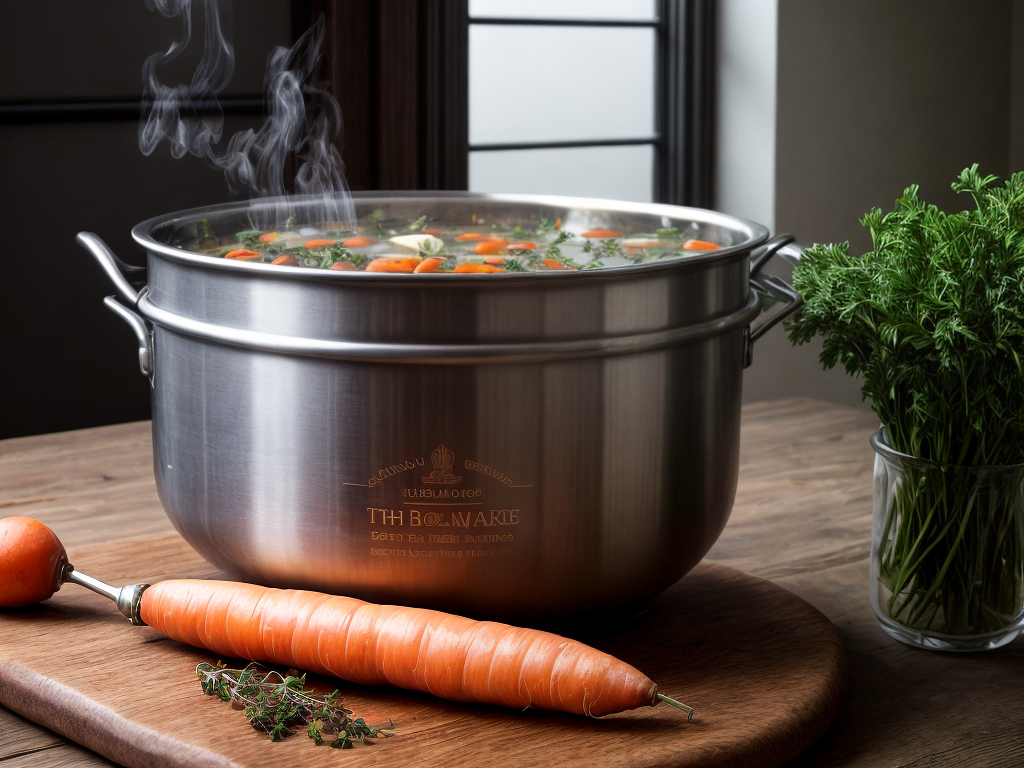
Making stock at home is like unlocking the hidden potential of your kitchen. It’s a skill that transforms simple ingredients into a flavorful elixir that adds depth and richness to any dish. But where do you start? How do you ensure that your homemade stock is packed with flavor and nutrients? In this discussion, I will guide you through the art of making stock at home, from choosing the right ingredients to mastering cooking techniques, and even troubleshooting common mistakes. Get ready to elevate your culinary creations to new heights.
Choosing the Right Ingredients
When making stock at home, it is crucial to carefully select the right ingredients for optimal flavor and quality. Choosing quality ingredients is the first step towards creating a delicious and nutritious stock. One important aspect of ingredient selection is sourcing local produce. By using locally grown vegetables, you not only support local farmers but also ensure that you are using fresh and seasonally available produce. Local produce is often harvested at its peak ripeness, resulting in enhanced flavor and nutritional value.
When sourcing vegetables for your stock, look for firm and blemish-free options. Carrots, celery, onions, and garlic are commonly used in stock recipes and can be easily found at local farmers’ markets or grocery stores. Ensure that the vegetables are free from mold or signs of decay, as these can affect the quality and safety of the stock.
In addition to vegetables, choosing quality bones is essential for a flavorful stock. If possible, opt for bones from organic, grass-fed animals, as they tend to have a richer taste and higher nutritional content. It is important to handle raw bones with care and follow proper food safety practices to avoid cross-contamination.
Preparing the Bones and Vegetables
To properly prepare the bones and vegetables for making stock at home, it is important to handle them with care and follow proper food safety practices. When it comes to bone preparation, it’s best to start with high-quality bones from a trusted source, such as a local butcher or farmer’s market. Make sure the bones are fresh and free from any signs of spoilage. If using meat bones, remove any excess fat or meat clinging to them. This will help prevent the stock from becoming greasy.
As for vegetable selection, opt for a variety of aromatic vegetables like onions, carrots, and celery. These vegetables add depth and flavor to the stock. Wash and peel them before using, and chop them into large chunks. The size of the vegetable pieces will depend on personal preference and the cooking time available.
It’s crucial to clean all utensils, cutting boards, and surfaces thoroughly after handling the bones and vegetables to prevent cross-contamination. Remember to wash your hands with warm, soapy water before and after handling these ingredients. Following these simple steps will ensure that your homemade stock is not only delicious but also safe to consume.
Cooking Techniques for Maximum Flavor
When it comes to maximizing flavor in homemade stock, there are two key techniques to keep in mind. First, using flavorful ingredient combinations can elevate the taste of the stock. Second, employing slow simmering techniques allows the flavors to fully develop and intensify. By following these cooking techniques, you can create a stock that is rich, flavorful, and perfect for enhancing a variety of dishes.
Flavorful Ingredient Combinations
For maximum flavor, incorporating flavorful ingredient combinations is essential in cooking techniques. When making homemade stock, experimenting with different flavor pairings can elevate the taste of your dishes. For a classic chicken stock, adding aromatic vegetables like onions, carrots, and celery enhances the overall flavor profile. To create a rich beef stock, consider including herbs like thyme and rosemary, along with mirepoix (a combination of onions, carrots, and celery). For a vegetable stock, combining vegetables like mushrooms, leeks, and tomatoes can add depth and complexity. Additionally, using spices such as bay leaves, peppercorns, and garlic can further enhance the flavor. Remember to always taste and adjust the seasonings as needed to ensure a well-balanced stock. By carefully selecting and combining ingredients, you can create homemade stock variations that will add a burst of flavor to your cooking.
Slow Simmering Techniques
Slow simmering techniques are essential for maximizing flavor in your cooking. When you slow cook your ingredients, you allow the flavors to meld together and create a rich and savory broth. Here are four slow cooking methods that will help you extract the nutrients and enhance the taste of your stock:
- Simmer on low heat: Maintain a gentle simmer rather than a rolling boil to prevent the stock from becoming cloudy or bitter.
- Use a slow cooker: Slow cookers are perfect for simmering stock over a long period, allowing the flavors to develop slowly and evenly.
- Braise or stew: These methods involve cooking the ingredients in a closed pot with a small amount of liquid for a long time, resulting in a flavorful and tender dish.
- Cook overnight: Letting your stock simmer overnight infuses it with deep flavors and ensures maximum extraction of nutrients.
The Importance of Simmering Time
When it comes to making stock at home, the simmering time is crucial. The longer you simmer, the more flavor you extract from the ingredients. This is why it’s important to have patience and let your stock simmer for an optimal duration to achieve the best results.
Optimal Simmering Duration
To achieve the best results when making stock at home, it is crucial to simmer the ingredients for the optimal duration, ensuring maximum flavor extraction. Here are four key factors to consider when determining the simmering duration:
-
Type of stock: Different stocks require different simmering times. For example, vegetable stock may only need 30-45 minutes, while chicken or beef stock may require 2-3 hours.
-
Flavorful ingredient combinations: The combination of ingredients affects the simmering time. For instance, if you’re using bones or tougher cuts of meat, a longer simmering time will be needed to extract their rich flavors.
-
Intensity of flavor: If you desire a more intense flavor, consider simmering the stock for a longer duration. This allows the flavors to meld together and develop a deeper, more robust taste.
-
Safety precautions: It’s important to follow food safety guidelines and avoid over-simmering. Prolonged simmering can lead to the breakdown of proteins, resulting in a cloudy and off-tasting stock.
Enhancing Flavor Through Simmering
To extract maximum flavor from the ingredients, it is crucial to simmer the stock for the appropriate duration. Simmering is a key step in flavor extraction, as it allows the ingredients to release their flavors and aromas into the liquid. The length of simmering time depends on the type of stock you’re making and the ingredients used. For a chicken stock, simmering for around 2 to 3 hours should be sufficient to extract the flavors from the bones and vegetables. However, for a richer and more intense flavor, you can simmer it for up to 4 to 6 hours. Simmering techniques such as low heat and gentle bubbling are essential to ensure that the flavors meld together harmoniously. Remember, the longer you simmer, the more concentrated and flavorful your stock will be.
The Role of Patience
Patience plays a crucial role in achieving the perfect simmering time for your homemade stock. When it comes to making stock, time management is essential. Here’s why:
-
Flavor development: Simmering the stock for a longer period allows the flavors to fully develop, resulting in a rich and flavorful broth.
-
Nutrient extraction: Patience is key to extracting all the valuable nutrients from the ingredients. The longer the simmer, the more minerals and vitamins are released into the stock.
-
Safety: Simmering the stock for an adequate amount of time ensures that any harmful bacteria or pathogens are destroyed, making the stock safe to consume.
-
Depth of flavor: Allowing the stock to simmer slowly allows the flavors to meld together, creating a complex and well-balanced taste.
Skimming and Straining for Clarity
Skimming and straining the stock is an essential step for achieving clarity and removing impurities. When making homemade stock, it is crucial to ensure that the final product is clear and free from any unwanted particles. To achieve this, there are specific skimming techniques and straining methods that can be employed.
Skimming techniques involve carefully removing any foam or scum that rises to the surface of the stock during the cooking process. This foam consists of impurities and fat that can cloud the clarity of the stock. By skimming off the foam regularly, you can maintain a clear and clean stock.
Once the stock has been simmered for an extended period, it is time to strain it. This removes any remaining solids or debris that may have accumulated during the cooking process. Using a fine mesh strainer or cheesecloth, carefully pour the stock through the strainer, allowing the liquid to pass through while trapping any unwanted particles.
To make it easier to understand, here is a table summarizing the skimming and straining techniques:
| Skimming Techniques | Achieving Clarity |
|---|---|
| Regularly skim off foam/scum | Remove impurities |
| Use a ladle or skimmer to skim | Maintain clarity |
| Skim from the surface of the stock | Ensure clean stock |
Storing and Freezing Homemade Stock
When it comes to storing and freezing homemade stock, proper containers and labeling are key to maintaining its quality and ensuring easy access in the future. Here are some tips to help you store your homemade stock effectively:
-
Choose the right containers: Use airtight containers made of plastic or glass. Mason jars with screw-top lids are great options. Avoid using metal containers, as they can affect the flavor of the stock.
-
Portion it out: Divide the stock into smaller portions before freezing. This will make it easier to thaw only the amount you need without having to defrost the entire batch.
-
Label everything: Clearly label each container with the date of preparation and the type of stock. This will help you keep track of how long the stock has been in the freezer and prevent any mix-ups.
-
Properly freeze and defrost: Allow the stock to cool completely before transferring it to the freezer. When defrosting, always thaw the stock in the refrigerator overnight or use the defrost setting on your microwave. Never defrost stock at room temperature, as it can promote bacterial growth.
Creative Ways to Use Homemade Stock
There are countless creative ways to incorporate homemade stock into your culinary repertoire. Not only does it add depth and flavor to your dishes, but it also provides a nutritious base for a variety of recipes. Here are some unique ways to use homemade stock:
| Creative Presentation | Unique Recipes |
|---|---|
| 1. Soup flights: Serve a trio of different soups in small cups, allowing your guests to sample and compare flavors. | 1. Risotto with stock: Use homemade stock instead of water to make a rich and flavorful risotto. |
| 2. Stock ice cubes: Freeze stock in ice cube trays and use them to add depth of flavor to sauces and pan sauces. | 2. Stock-based cocktails: Infuse your favorite cocktails with homemade stock for a unique twist. |
| 3. Stock-based gravy: Make a velvety smooth gravy by using homemade stock as the base. | 3. Stock-based marinades: Use homemade stock to marinate meats and vegetables for added flavor. |
| 4. Stock-based popsicles: Create savory popsicles by freezing homemade stock with herbs and vegetables for a refreshing and unique treat. | 4. Stock-infused rice: Cook rice with homemade stock to give it a delicious and aromatic flavor. |
These creative presentations and unique recipes will elevate your cooking to new heights. Experiment with different flavor combinations and let your homemade stock shine in unexpected ways. Enjoy the versatility and depth that homemade stock brings to your dishes!
Troubleshooting Common Stock-Making Mistakes
To ensure a successful batch of homemade stock, it is important to address and troubleshoot common mistakes that may arise during the stock-making process. Here are four key points to consider when troubleshooting stock-making mistakes:
-
Preventing stock spoilage: One of the most common mistakes is not properly storing the stock. To prevent spoilage, always cool the stock completely before refrigerating or freezing it. Make sure to store it in airtight containers, and label them with the date to keep track of freshness. Additionally, if you notice any off smells or discoloration, discard the stock immediately.
-
Troubleshooting stock consistency: If your stock turns out too thin or lacking in flavor, it might be due to not simmering it long enough or using an inadequate ratio of ingredients. Ensure you simmer the stock for the recommended amount of time, typically at least 4 to 6 hours, to extract maximum flavor. Also, make sure to use a good balance of bones, meat, and vegetables to achieve a rich and flavorful stock.
-
Straining the stock: Straining the stock is crucial for a clear and smooth consistency. If your stock appears cloudy, it might be due to not straining it properly. Use a fine-mesh strainer or cheesecloth to remove all impurities and particles. You can strain it multiple times if necessary, ensuring a clean and clear stock.
-
Adjusting seasoning: Stock should be seasoned lightly during the cooking process and adjusted to taste at the end. If your stock tastes bland, try adding a pinch of salt and a touch of acidity, like lemon juice or vinegar, to enhance the flavors. Remember to taste and adjust the seasoning gradually, as you can always add more but cannot remove excess salt.
Conclusion
In conclusion, making homemade stock is an art that requires attention to detail and the right techniques. By choosing the right ingredients, preparing them properly, and using cooking techniques that enhance flavor, you can create a stock that adds depth and richness to your dishes. Simmering time, skimming, and straining are important steps to achieve clarity in your stock. Storing and freezing homemade stock allows for convenient use in future recipes. Remember, with a little practice and troubleshooting, anyone can master the art of making stock at home.






